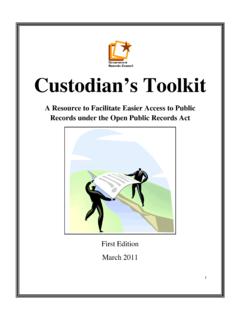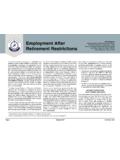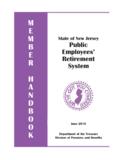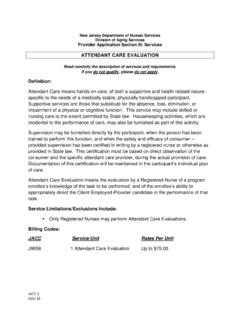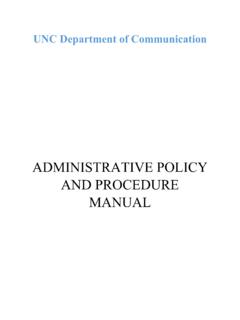Transcription of Use of force policy - Government of New Jersey
1 USE OF force policy Office of the Attorney General | State of New Jersey D ecem ber 2 02 0 Versio n USE OF force policy | December 2020 i Contents Core Principles .. ii Definitions .. iii Core Principle One .. 1 Core Principle Two .. 2 Core Principle Three .. 6 Core Principle Four .. 13 Core Principle Five .. 17 Core Principle Six .. 18 Core Principle Seven .. 19 Appendices Addendum A Conducted Energy Devices and Other Less-Lethal Devices and Ammunition Addendum B Vehicular Pursuit policy USE OF force policy | December 2020 ii Core Principles 1 The Sanctity of Human Life and Serving the Community. In serving the community, law enforcement officers (hereinafter officers ) shall make every effort to preserve and protect human life and the safety of all persons. Officers shall respect and uphold the dignity of all persons at all times in a non-discriminatory manner.
2 2 force as a Last Resort and Duty to De-Escalate. force shall only be used as a last resort when necessary to accomplish lawful objectives that cannot reasonably be achieved through verbal commands, critical decision making, tactical deployment or de-escalation techniques. force shall never be used as a retaliatory or punitive measure. 3 Duty to Use Only Objectively Reasonable, Necessary, and Proportional force . Officers shall use the least amount of force that is objectively reasonable, necessary and proportional to safely achieve the legitimate law enforcement objective under the circumstances. 4 Duty to Use Deadly force Only as an Absolute Last Resort and Duty to Avoid Actions Which Create a Substantial Risk of Death or Serious Bodily Injury. Deadly force shall only be used as an absolute last resort and in strict compliance with this policy .
3 Other actions by law enforcement that create a substantial risk of death or serious bodily injury must be avoided or employed only under the strictest of conditions. 5 Duty to Intervene and Report. Every officer, regardless of rank, title, seniority, or status, has an affirmative duty to take steps to prevent any use of force that is illegal, excessive, or otherwise inconsistent with such policies, regulations, and laws, if possible, before a fellow officer uses excessive, illegal, or otherwise inappropriate force . Every officer has a duty to immediately report any improper use of force . 6 Duty to Render Medical Assistance. After any use of force , and when the environment is safe, officers shall promptly render medical assistance to any injured person consistent with the officer s training and shall promptly request emergency medical assistance for that person, if needed or requested.
4 Officers also have a duty to monitor individuals for potential medical intervention after any officer uses force . 7 Duty to Report and Review Uses of force . Every use of force must be reported and receive a meaningful command level review as set forth in a written department policy that includes review by the law enforcement executive. The law enforcement executive shall also conduct an annual review and analysis of the overall use of force by the department. USE OF force policy | December 2020 iii Definitions Active Assailant. A person who is using or imminently threatening the use of force , with or without a weapon, in an aggressive manner that poses a substantial risk of causing bodily injury to an officer or another person. A threatening assailant becomes an active assailant when the threat becomes imminent.
5 Active Resistor. A person who is uncooperative, fails to comply with directions from an officer, and instead actively attempts to avoid physical control. This type of resistance includes, but is not limited to, evasive movement of the arm, flailing arms, tensing arms beneath the body to avoid handcuffing, and flight. Bodily Injury. Physical pain or temporary disfigurement, or any impairment of physical condition. Bodily harm and bodily injury have the same definition for the purposes of this policy . See 2C:11-1(a); 2C:3-11(e). Civil Disturbance. An assembly of persons engaged in or creating an immediate threat of collective violence, destruction of property, looting, or other criminal acts. Such a gathering may also be referred to as a riot. Chokehold. A technique that involves applying direct pressure to a person s trachea (windpipe) or airway (front of the neck) with the effect of reducing the intake of air.
6 This includes a carotid restraint or any lateral neck restraint, where direct pressure is applied to the carotid artery restricting the flow of blood to the brain causing temporary loss of consciousness. Conducted Energy Device (CED). A CED means any device approved by the Attorney General that is capable of firing darts/electrodes that transmit an electrical charge or current intended to temporarily disable a person. Constructive Authority. Constructive authority is not considered a use of force because it does not involve physical contact with the subject. Rather, constructive authority involves the use of the officer s authority to exert control over a subject. Examples include verbal commands, gestures, warnings, and unholstering a weapon. Pointing a firearm at a subject is an example of constructive authority to be used only in appropriate circumstances outlined in Section of this policy .
7 Cooperative Person. A person who responds to and complies with an officer s directions. Critical Decision-Making Model. The Critical Decision-Making Model is an organized way of making decisions about how an officer will act in any situation, including those that may involve potential uses of force . De-escalation. De-escalation refers to the action of communicating verbally or non-verbally in an attempt to reduce, stabilize, or eliminate the immediacy of a threat. De-escalation may also be USE OF force policy | December 2020 iv used to create the time needed to position additional resources to resolve the situation with the least amount of force necessary. Deadly force . force that an officer uses with the purpose of causing, or that a reasonable officer knows creates a substantial risk of causing death or serious bodily injury.
8 Discharging a firearm, constitutes deadly force , unless the discharge occurred during the course of a law enforcement training exercise, routine target practice at a firing range, a lawful animal hunt, or the humane killing of an injured animal. A threat to cause death or serious bodily injury by the display of a weapon or otherwise, so long as the officer s purpose is limited to creating an apprehension that deadly force will be used if necessary, does not constitute deadly force . Enhanced Mechanical force . An intermediate force option between mechanical force and deadly force , generally requiring a greater level of justification than that pertaining to physical or mechanical force , but a lower level of justification than that required for the use of deadly force . Unlike deadly force , enhanced mechanical force does not require an imminent threat of death or serious bodily injury.
9 Examples include conducted energy devices and less-lethal devices and ammunition. Feasible. Reasonably capable of being accomplished or carried out, given the totality of the circumstances, in a manner that maintains the safety of the public and officers. Imminent Danger. Threatened actions or outcomes that are immediately likely to occur during an encounter absent action by the officer. The period of time involved is dependent on the circumstances and facts evident in each situation and is not the same in all situations. The threatened harm does not have to be instantaneous, for example, imminent danger may be present even if a subject is not at that instant pointing a weapon at the officer, but is carrying a weapon and running for cover to gain a tactical advantage. Law Enforcement Executive.
10 A law enforcement agency s highest-ranking sworn law enforcement officer, typically the chief of police. In situations where the highest-ranking officer is recused from a matter, then law enforcement executive refers to the next highest-ranking officer without a conflict. Law Enforcement Officer. Any person who is employed as a sworn member of any state, county, or municipal law enforcement agency, department, or division of those governments who is statutorily empowered to act for the detection, investigation, arrest, conviction, detention, or rehabilitation of persons violating the criminal laws of this State. The term law enforcement officer shall include sworn members of the New Jersey State Police, the Division of Criminal Justice and the Juvenile Justice Commission. It shall include State Correctional Police Officers pursuant to 2A:154-4, County Correctional Police Officers pursuant to 2A:154-3, Special Law Enforcement Officers of all classes pursuant to 40 et seq.
